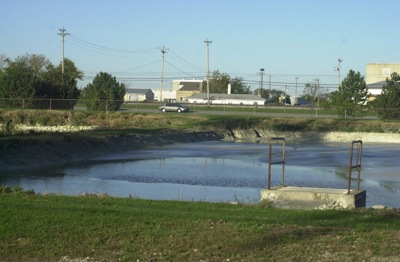Friday, October 13th, 2006
Consultant suggests moving sludge lagoons
By Timothy Cox

Photo by Mark Pummell/The Daily Standard
Celina city officials are renewing discussion on possibly relocating the unsightly sludge lagoons from the south edge of town along U.S. 127 to a more secluded location.
Relocating the city of Celina's unsightly sludge lagoons on the south edge of town is being talked about again.
City officials for years have discussed the possibility of finding a new place for the ponds, but have struggled to come up with viable solutions. The lagoons are filled with material from the water plant that settles out of the water drawn from Grand Lake. In addition to being an eyesore, there sometimes is a foul odor emitted from the ponds.
City developmental consultant Kent Bryan mentioned the issue this week during a joint meeting between Celina city administration officials and Mercer County Commissioners.
Bryan told commissioners he would like to work with them on a potential partnership to relocate the lagoons west of the city. He specifically cited a large swath of county-owned land along Fleetfoot Road near the intersection of state Route 29.
Bryan did not discuss further details of his plans, but told commissioners he would like to work with engineer Jared Ebbing on a formal proposal. Ebbing works for Fanning-Howey Associates, which is under contract with the county for water and sewer work.
The city last considered relocating its sludge lagoons a couple of years ago as part of a complex deal involving the relocation of a city business. Under terms of that deal, Celina would have paid Alumacast to relocate from West Livingston Street to the Grand Lake Industrial Park. The existing Alumacast facility would have been moved near the city water plant where the sludge would have been stored inside the building.
The deal fell through when it failed to garner support from city council members.
Architects who crafted a lakefront revitalization plan for the city several years ago also mentioned the sludge ponds. They recommended the lagoons be moved away from the "gateway" to the community, but offered no details on how to do so.
If vacated, the land nestled between U.S. 127 and Grand Lake Road would be prime real estate, although city officials have not said whether they would use the property or attempt to sell it.




